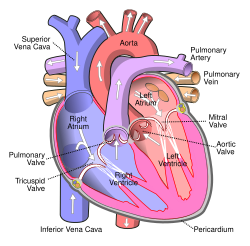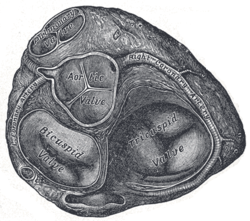| Mitral valve | |
|---|---|
 Anterior (frontal) view of the opened heart. White arrows indicate normal blood flow. (Mitral valve labeled at center right.) | |
 Base of ventricles exposed by removal of the atria. (Bicuspid (mitral) valve visible at bottom left.
Tricuspid valve visible at bottom right.) | |
| Details | |
| Identifiers | |
| Latin | valva atrioventricularis sinistra, valva mitralis, valvula bicuspidalis |
| MeSH | D008943 |
| TA98 | A12.1.04.003 |
| TA2 | 3987 |
| FMA | 7235 |
| Anatomical terminology | |
The mitral valve (/ˈmaɪtrəl/), also known as the bicuspid valve or left atrioventricular valve, is one of the four heart valves. It has two cusps or flaps and lies between the left atrium and the left ventricle of the heart. The heart valves are all one-way valves allowing blood flow in just one direction. The mitral valve and the tricuspid valve are known as the atrioventricular valves because they lie between the atria and the ventricles.[1]
In normal conditions, blood flows through an open mitral valve during diastole with contraction of the left atrium, and the mitral valve closes during systole with contraction of the left ventricle. The valve opens and closes because of pressure differences, opening when there is greater pressure in the left atrium than ventricle and closing when there is greater pressure in the left ventricle than atrium.[2]
In abnormal conditions, blood may flow backward through the valve (mitral regurgitation) or the mitral valve may be narrowed (mitral stenosis). Rheumatic heart disease often affects the mitral valve; the valve may also prolapse with age and be affected by infective endocarditis. The mitral valve is named after the mitre of a bishop, which resembles its flaps.[3][4]
- ^ Standring, Susan, ed. (2016). Gray's Anatomy: The Anatomical Basis of Clinical Practice. Philadelphia. ISBN 9780702052309. OCLC 920806541.
{{cite book}}: CS1 maint: location missing publisher (link) - ^ Guyton, Arthur C.; Hall, John E. (2011). Guyton and Hall's Textbook of medical physiology (Twelfth ed.). Philadelphia, Pa. ISBN 9781416045748. OCLC 434319356.
{{cite book}}: CS1 maint: location missing publisher (link) - ^ NORRIS, TOMMIE L. (2018). PORTH'S PATHOPHYSIOLOGY : concepts of altered health states. [Place of publication not identified]: WOLTERS KLUWER HEALTH. ISBN 978-1496377593. OCLC 1054224262.
- ^ Harrison's principles of internal medicine. Kasper, Dennis L.,, Fauci, Anthony S., 1940-, Hauser, Stephen L.,, Longo, Dan L. (Dan Louis), 1949-, Jameson, J. Larry,, Loscalzo, Joseph (19th ed.). New York. 2015-04-08. ISBN 9780071802154. OCLC 893557976.
{{cite book}}: CS1 maint: location missing publisher (link) CS1 maint: others (link)